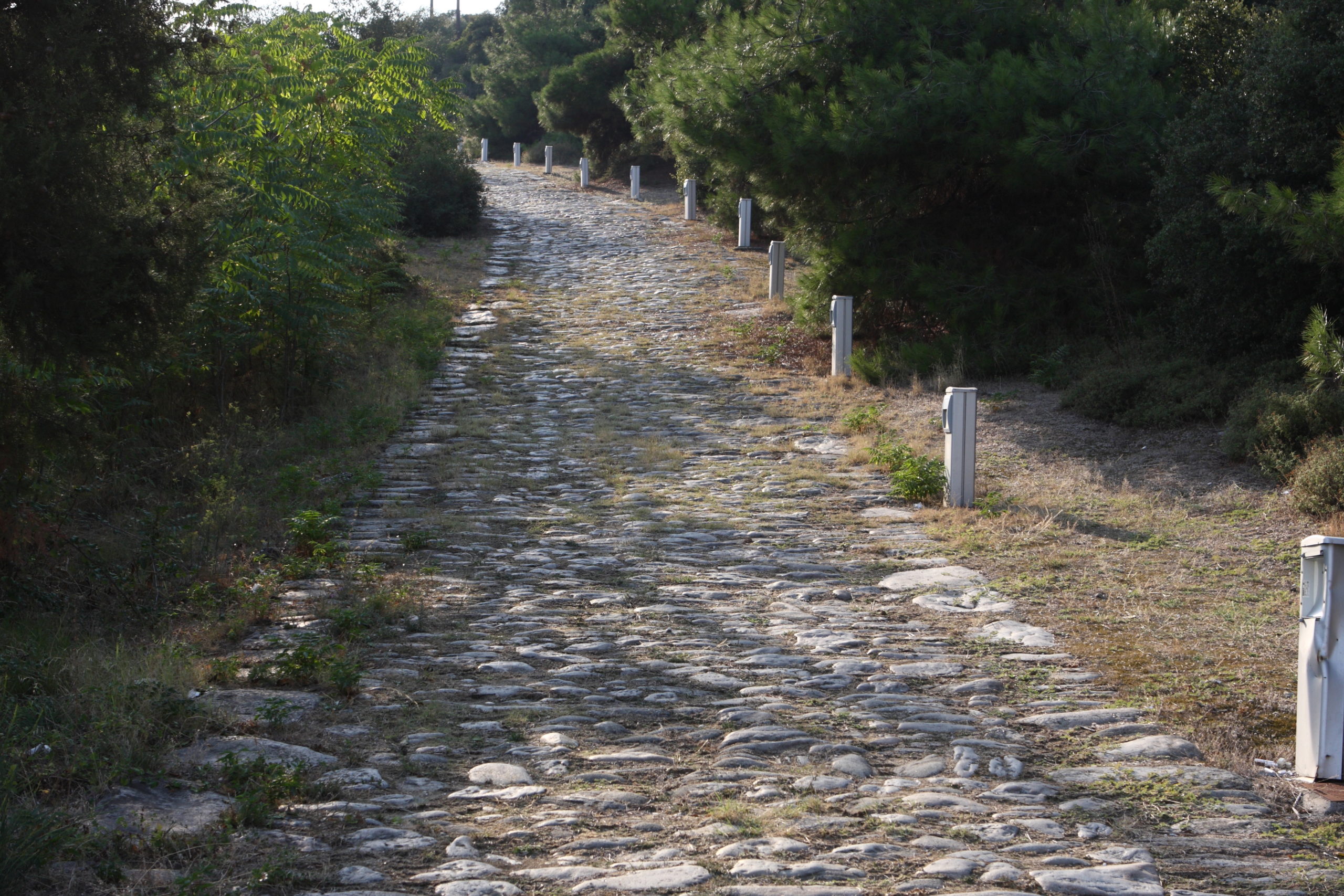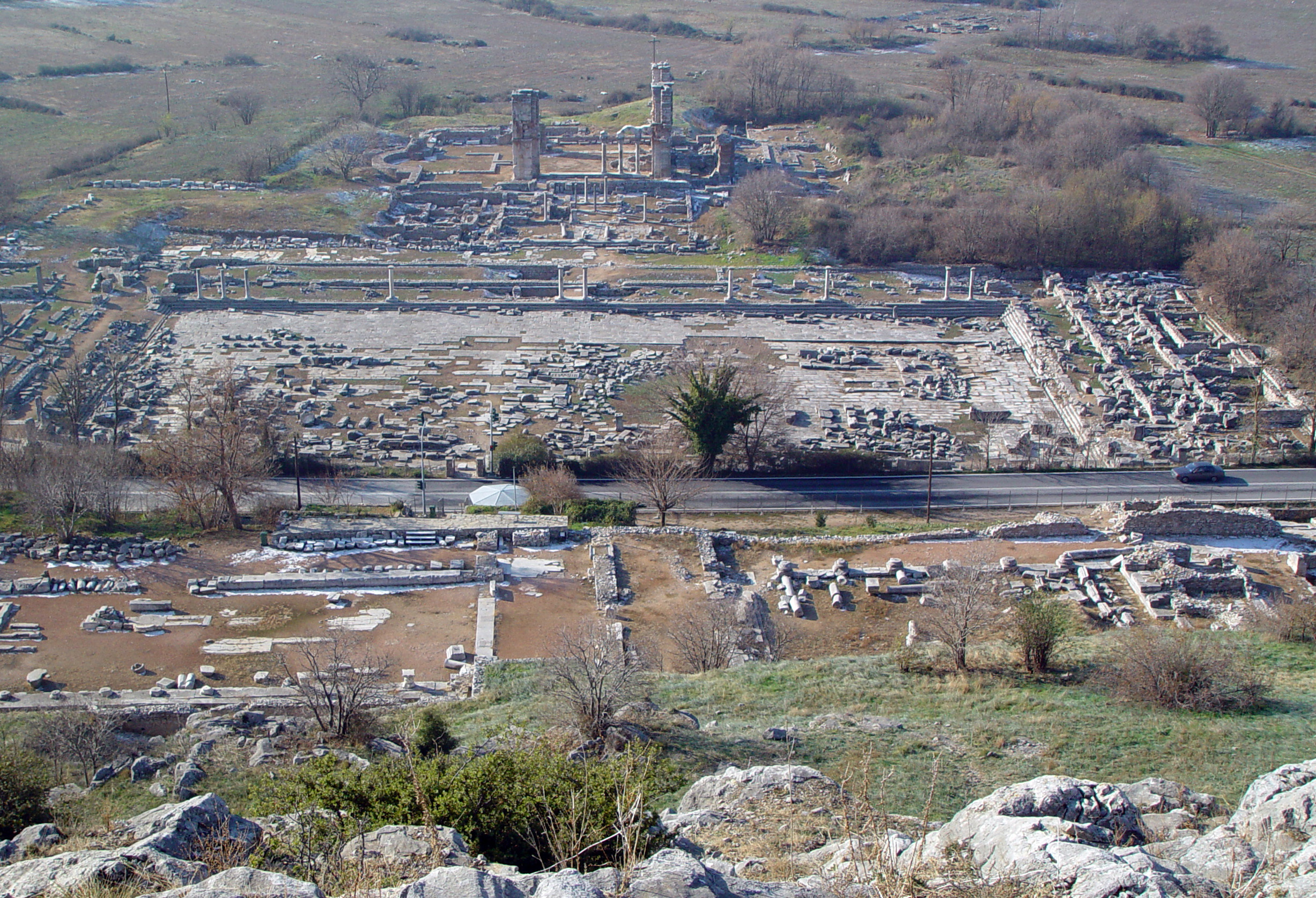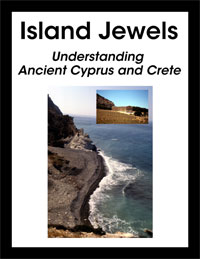
Remains of the Via Egnatia at Neapolis (modern Kavala) near Philippi. By Philipp Pilhofer – Own work, CC BY-SA 3.0, via Wikimedia Commons.
The Via Egnatia, which ran from Constantinople in the east to Dyrrachium, Albania, in the west, was one portion of the more than 50,000 miles of well-built roads of the Roman Empire. It was along the Via Egnatia, in part, that Paul and his companions spread the Christian message, visiting friends and family, preaching in city markets, and dispatching letters to communities that had welcomed them.
The most prominent region traversed by the Via Egnatia and visited by Paul was Macedonia (e.g., Romans 15:26; 2 Corinthians 1:16; 1 Thessalonians 1:7). Within this region, two of the major cities associated with the early Jesus movement were Thessaloniki (Salonica) and Philippi, and Paul’s letters to the Thessalonians and Philippians are among the earliest surviving examples of Christian literature.[1] These two cities are also among the most extensively excavated in Greece and provide important archaeological information about the social and religious context of the early Jesus movement.
What becomes readily apparent from the archaeological evidence is that pagan cults were alive and well not only during the early years of the empire as Christianity spread but also long afterwards, and female deities were often especially popular. Indeed, many within these cities continued to worship traditional deities even as they added Jesus to their religious repertory.
At Thessaloniki and Philippi, evidence has been found for the veneration of a wide array of gods and goddesses. Here we will focus on the Egyptian goddess Isis, who, though a relative newcomer to the pantheon, became quite popular throughout the empire.
Isis and Serapis
Temples, shrines, and statues to Isis have been found throughout the empire. Isis’s popularity was undoubtedly due to her various attributes—a healing deity, the ideal wife and mother, and all-powerful, associated with both life and death.
The ancient Egyptian gods—Osiris (Serapis), his wife/sister Isis, and their son Horus—spread into Greece and elsewhere in the Hellenistic era through trade routes. They ultimately became among the most popular non-Greek deities in the first two centuries CE. Their cult, propelled primarily by Isis, was based on an elaborate mythology, and temple practices included processions and initiation ceremonies. Isis was also often associated with other goddesses and female figures such as Sophia (Wisdom). These links will become important as we examine Isis’s influence on the veneration of Mary, the mother of Jesus.
Isis and Mary at Thessaloniki
Thessaloniki had a long and rich history. Founded by the Macedonian king Cassander in c. 315 BCE, it was “a vibrant and politically significant metropolitan center” from its founding into the Byzantine era. [2] In Roman times, it was the chief port of Macedonia, the capital of the Roman province. In the Byzantine era, at least three basilicas were constructed in the city: St. Demetrios, Acheiropoietos, and another that has been identified beneath the standing remains of the city’s Hagia Sophia church.

The Basilica of St. Demetrius, Thessaloniki, Greece. By C messier – Own work, CC BY-SA 4.0, via Wikimedia Commons.
Like other Greco-Roman cities, Thessaloniki’s religious environment was extremely diverse. While evidence for the cults of Kybele, Mithras, Dionysos, Herakles, Apollo, and Aphrodite have been found, it was the worship of Isis and Serapis that was especially prominent.
As Christianity developed in the second and third centuries, devotees worshiped gods as city or protector deities. Thessaloniki’s patron deity was the Cabiros, a young prince murdered by his two brothers. Later legends about the Christian martyr St. Demetrios (early fourth century) portrayed the saint as the city’s new protector, replacing the Cabiros. In the St. Demetrios legends, Lady Eutaxia, the female personification of civil order, was always present with the saint.
According to archaeologist Charalambos Bakirtzis, St. Demetrios shared the basilica with Mary in a similar way that Serapis shared a temple and altar with Isis. Ever-present Lady Eutaxia was equated with the goddess Tyche (Fortune) of the city.
There are yet other important links between the traditional pagan deities and the Christian pantheon. The iconography of Isis nursing Horus became a template for Mary and the infant Jesus.[3] This imagery is especially significant for women: mother (Isis, Mary), son (Horus, Jesus), and mother’s milk (nursing). These connections converge specifically at Thessaloniki in that, by the end of the sixth century, the city was providing free medical care in the basilica of St. Demetrios. Health and healing were pervasive aspects of many traditional cults. Thus, treatments at the hospital in the basilica paralleled those practiced in the local Serapis sanctuary and in many other cults of antiquity.[4]
Furthermore, many of the Christian mosaics at St. Demetrios depict children, and an inscription connected with one of these mosaics gives thanks to Mary, the mother of God, for an act of healing. This indicates, therefore, that the basilica had effectively replaced the Serapis sanctuary as the city and region’s primary healing center.
Our website, blog and email newsletter are a crucial part of Biblical Archaeology Society's nonprofit educational mission
This costs substantial money and resources, but we don't charge a cent to you to cover any of those expenses.
If you'd like to help make it possible for us to continue Bible History Daily, BiblicalArchaeology.org, and our email newsletter please donate. Even $5 helps:

Isis and Mary at Philippi
Though smaller than Thessaloniki, Philippi was also quite prominent in the first centuries CE, having been the site of Antony and Octavian’s victory over Brutus and Cassius in 42 BCE. Excavations at Philippi have revealed the Roman forum, including temples to the emperor and empress, a colossal monument to the deified Livia (wife of Emperor Augustus), and the remains of six early Byzantine basilicas.

The remains of the Roman forum at ancient Philippi in Greece. CC BY-SA 3.0, via Wikimedia Commons.
The Philippians venerated the male divinities Sylvanus, Dionysos, and the Thracian Horseman for centuries. Similarly to Thessaloniki, however, its major deities in the early imperial era were the goddesses Artemis (Diana) and Isis, both healing deities and both linked to women and children.[5] The Isis temple at Philippi was built very close to the Artemis reliefs that are carved on the acropolis hill, probably because of the healing springs that were once to be found there.
Since prehistoric times, healing was seen to be accomplished through water and milk—that is, mother’s milk—both of which continued to be associated with Greco-Roman goddesses. Thus, the images of Isis/Horus and Mary/Jesus connect the elements of the ideal mother who nourishes her child, the healing and health-promoting powers of her milk, and the curative properties of water. Philippi emerged over time as a pilgrimage site for people in need of healing in its cultic waters, which were linked to female deities.[6]
All of this evidence sheds important light on the growth of Christianity at Thessaloniki and Philippi. The emergence of a strong attachment to Mary, the mother of Jesus, at these cities and elsewhere suggests that the replacement of a female deity by an all-male godhead—Jesus and his father—was inconceivable to many pagans. When Christianity eventually prevailed, adherents turned to Jesus and his mother Mary who resembled many of their traditional goddesses.
About the Author
Valerie Abrahamsen is an independent scholar who holds masters and doctoral degrees in New Testament and Early Christian Origins from Harvard Divinity School. She is the author of more than three dozen articles, reviews, and book chapters in New Testament archaeology, early church history, women in antiquity, and ancient goddess religions, and she has published two books in these fields: Women and Worship at Philippi (1995) and Goddess and God: A Holy Tension in the First Christian Centuries(2006).

Notes:
[1.] Most New Testament scholars believe that the second letter to the Thessalonians was not actually written by Paul and likely dates to several decades after Paul’s death.
[2.] Laura Nasrallah, “Introduction,” in Laura Nasrallah, Charalambos Bakirtzis, and Steven J. Friesen, eds, From Roman to Early Christian Thessalonikē: Studies in Religion and Archaeology (Cambridge, MA: Harvard University Press, 2010), p. 1.
[3.] Robert J. Miller, Born Divine: The Births of Jesus and Other Sons of God (Santa Rosa, CA: Polebridge, 2003), pp. 300–301.
[4.] Charalambos Bakirtzis, “Late Antiquity and Christianity in Thessalonikē: Aspects of a Transformation,” in Laura Nasrallah, Charalambos Bakirtzis, and Steven J. Friesen, eds., From Roman to Early Christian Thessalonikē: Studies in Religion and Archaeology (Cambridge, MA: Harvard University Press, 2010), p. 401.
[5.] Lilian Portefaix, Sisters Rejoice, New Testament Series 20 (Uppsala: Coniectanea Biblica, 1988), pp. 81–82, 117–119.
[6.] Valerie A. Abrahamsen, Women and Worship at Philippi: Diana/Artemis and Other Cults in the Early Christian Era (Portland, ME: Astarte Shell, 1995).
Read more in Bible History Daily:
Paul’s First Missionary Journey through Perga and Pisidian Antioch
Read more in the BAS Library:
The apostle Paul traveled extensively throughout the Roman Empire to spread the teachings of Jesus. He spread the gospel for seven years across thousands of miles. What does archaeology tell us about the places he visited? Why did he stay in Corinth and Ephesus? Why did he take a treacherous route through Anatolia? What was travel like in Paul’s time? Why did Paul travel so far west–and did he also evangelize east in Arabia? BAS editors have compiled BAR and Bible Review articles that explore the cities, roads and peoples Paul encountered on his journey through the first-century Mediterranean. Read more in the BAS Library about Paul’s Journeys.
Not a BAS Library or All-Access Member yet? Join today.

.
The post Mary, Isis, and the Goddesses of the Via Egnatia appeared first on Biblical Archaeology Society.


0 Commentaires